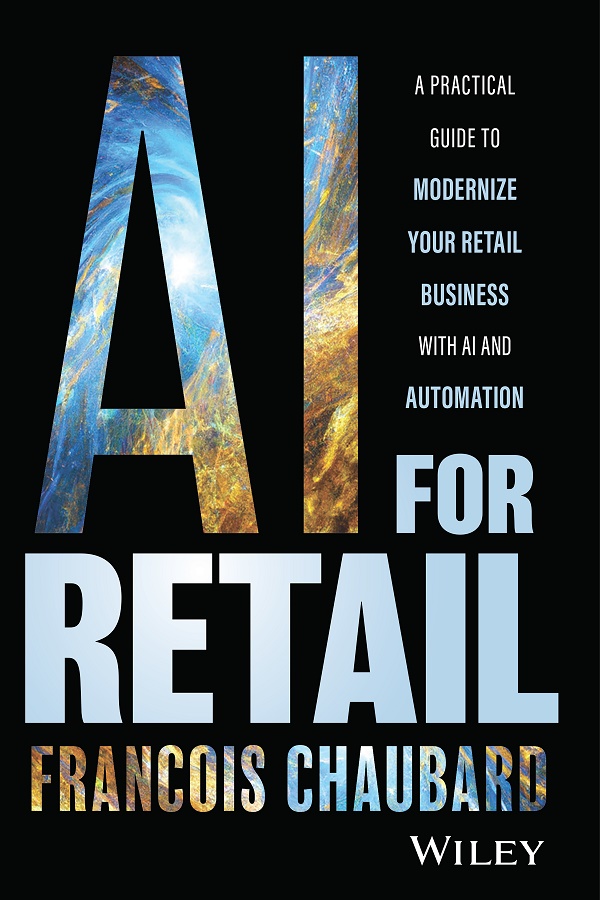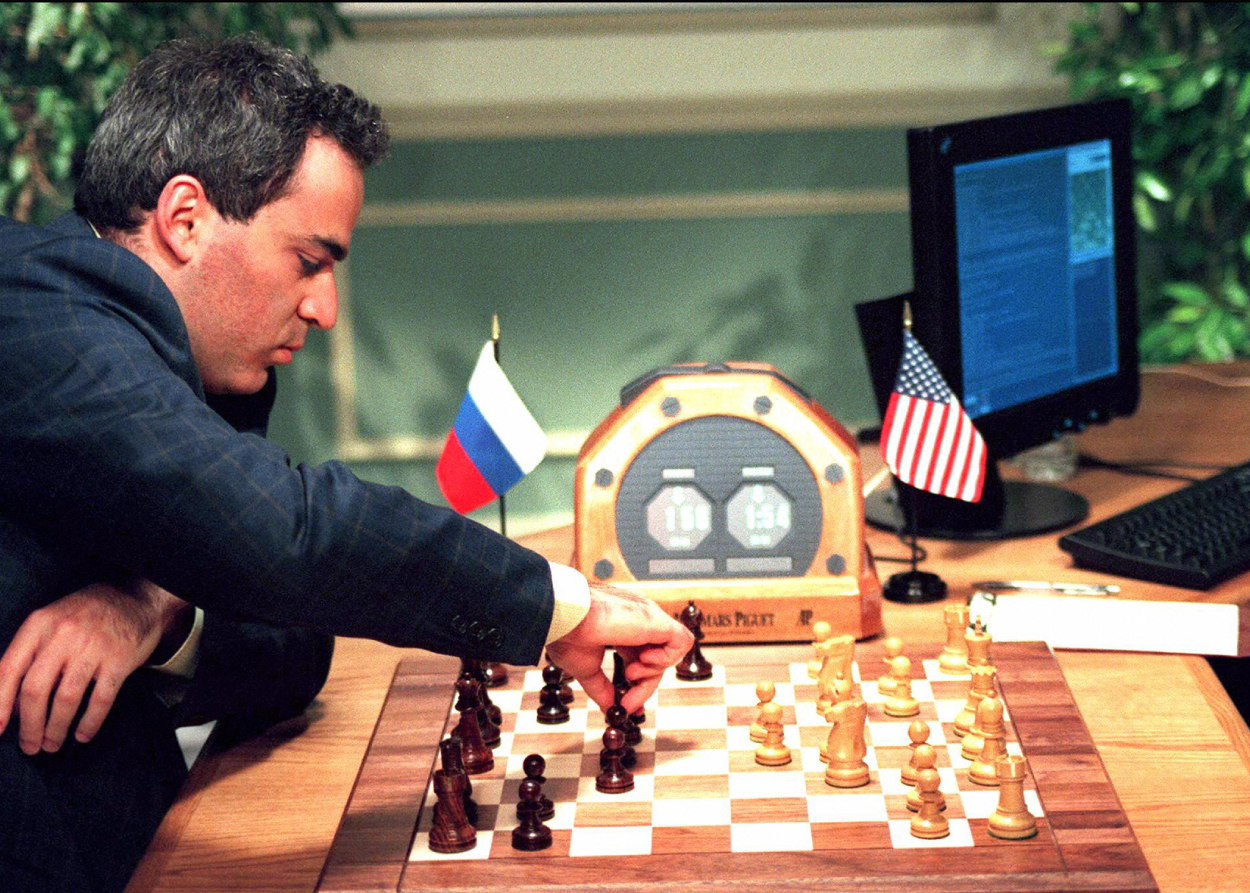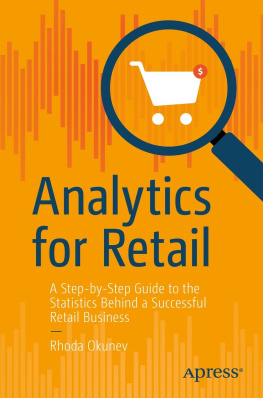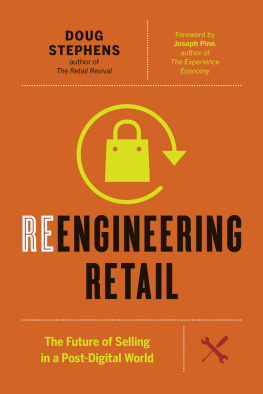
Table of Contents
List of Illustrations
- Introduction
- Chapter 1
- Chapter 2
- Chapter 3
- Chapter 4
- Chapter 5
- Chapter 6
- Chapter 7
- Chapter 8
- Chapter 9
- Chapter 10
- Chapter 11
- Chapter 12
- Chapter 13
- Chapter 15
- Chapter 16
- Chapter 17
- Chapter 18
- Chapter 19
- Chapter 20
- Chapter 21
- Chapter 22
- Chapter 23
- Chapter 24
- Chapter 25
- Chapter 26
- Chapter 27
Guide
Pages
AI FOR RETAIL
A PRACTICAL GUIDE TO MODERNIZE YOUR RETAIL BUSINESS WITH AI AND AUTOMATION
FRANCOIS CHAUBARD

Copyright 2023 by John Wiley & Sons, Inc. All rights reserved.
Published by John Wiley & Sons, Inc., Hoboken, New Jersey.
Published simultaneously in Canada.
The Wiley cover designer generated the typefill image in part with DALLE 2, OpenAI's largescale imagegeneration model. Upon generating a draft image, the Wiley designer reviewed, edited, and revised the image to their liking. Wiley is responsible for the image content of this book's cover.
No part of this publication may be reproduced, stored in a retrieval system, or transmitted in any form or by any means, electronic, mechanical, photocopying, recording, scanning, or otherwise, except as permitted under Section 107 or 108 of the 1976 United States Copyright Act, without either the prior written permission of the Publisher, or authorization through payment of the appropriate percopy fee to the Copyright Clearance Center, Inc., 222 Rosewood Drive, Danvers, MA 01923, (978) 7508400, fax (978) 7504470, or on the web at www.copyright.com. Requests to the Publisher for permission should be addressed to the Permissions Department, John Wiley & Sons, Inc., 111 River Street, Hoboken, NJ 07030, (201) 7486011, fax (201) 7486008, or online at http://www.wiley.com/go/permission.
Trademarks: Wiley and the Wiley logo are trademarks or registered trademarks of John Wiley & Sons, Inc. and/or its affiliates in the United States and other countries and may not be used without written permission. All other trademarks are the property of their respective owners. John Wiley & Sons, Inc. is not associated with any product or vendor mentioned in this book.
Limit of Liability/Disclaimer of Warranty: While the publisher and author have used their best efforts in preparing this book, they make no representations or warranties with respect to the accuracy or completeness of the contents of this book and specifically disclaim any implied warranties of merchantability or fitness for a particular purpose. No warranty may be created or extended by sales representatives or written sales materials. The advice and strategies contained herein may not be suitable for your situation. You should consult with a professional where appropriate. Further, readers should be aware that websites listed in this work may have changed or disappeared between when this work was written and when it is read. Neither the publisher nor authors shall be liable for any loss of profit or any other commercial damages, including but not limited to special, incidental, consequential, or other damages.
For general information on our other products and services or for technical support, please contact our Customer Care Department within the United States at (800) 7622974, outside the United States at (317) 5723993 or fax (317) 5724002.
Wiley also publishes its books in a variety of electronic formats. Some content that appears in print may not be available in electronic formats. For more information about Wiley products, visit our web site at www.wiley.com.
Library of Congress CataloginginPublication Data is Available:
ISBN 9781394184699 (Cloth)
ISBN 9781394184705 (ePub)
ISBN 9781394184712 (ePDF)
Cover Design: Wiley
Cover Image: Wiley/DALLE 2/OpenAI
I dedicate this book to four incredible groups of people. First, my wife Taylor, who has been my rock through the highs and lows of this entrepreneurial journey. Second, to my team at Focal Systems, who inspire me every day as they lead the charge globally on applying AI to retail. Third, to all the mentors and advisors throughout my life who have taken me to school on retail, AI, how to build a successful business, and how to live a useful and fulfilling life that will continue to serve the world posthumously. And finally, to the Billy Beanes of retail who will have the courage and motivation to take these ideas the full distance to transform retail completely. I hope this book makes all of you proud.
Introduction: Why You Need This Book as a Retail Leader
In the summer of 1997, I was 10 and just entering the fifth grade on the outskirts of Manhattan. My father and I would play chess together most nights, and I enjoyed it very much. That year was perhaps the most exciting time in chess history since its invention 1,500 years ago. On May 11, 1997, not far from my home in downtown Manhattan, World Chess Champion Garry Kasparov faced off against IBM supercomputer Deep Blue (see ). In a battle of man versus machine, the world gasped as the unthinkable occurred. Kasparov stood up and walked away in game six, thereby conceding the game to Deep Blue. AI won. This was an omen to the world of the transformation AI was soon to cause. This irrevocably peaked my interest in computers. After that year, my love for chess evolved into a passion for computer programming and AI.

Gary Kasparov vs. Deep Blue, May 11, 1997.
Source: STAN HONDA / Getty Images.
A year later, my sixth grade teacher brought our entire class on a field trip to visit the New York Stock Exchange (NYSE). I remember vividly as I entered the main hall, I was nearly knocked over by the raucous ballet of men and women in lab coats belting SELL, SELL, SELL, or BUY, BUY, BUY. If you haven't experienced this yourself, Ferris Bueller's Day Off does a great job documenting this wild skirmish. In the midst of the chaos, I thought to myself, How do they know what to buy? How much to offer? How do they know they are getting a good deal? I asked our tour guide all of these questions.
The tour guide replied, Experience, son; these brokers have been buying and selling stock for decades. They are the best in the world. Naively thinking about Gary's stunning defeat, who was also the best in the world at his craft, I asked, Do you think a computer could ever beat them like Gary Kasparov? The tour guide smiled at me with confidence, and dismissed the notion. Not a chance, he said.
He was wrong.
Over the next 20 years, almost all of the trading volume on the NYSE would migrate to AIgenerated trades. Every day, AI algorithms ingest billions of rows of realworld data, and every millisecond, they compute predictions on the future stock price to find arbitrage opportunities that humans could never find. In 2003, 15% of all trading volume on the NYSE was generated from a computer program. By 2016, 80% of all trading volume was generated from a computer program. Today this is closer to 95% (see ).
If you visit the NYSE now, the raucous ballet is gone. Today, you could hear a pin drop on the trading floor (see ). The traders were all laid off and replaced with quants, experts in analyzing and managing quantitative data, to create AI models to predict the right trades to make.
Next page










